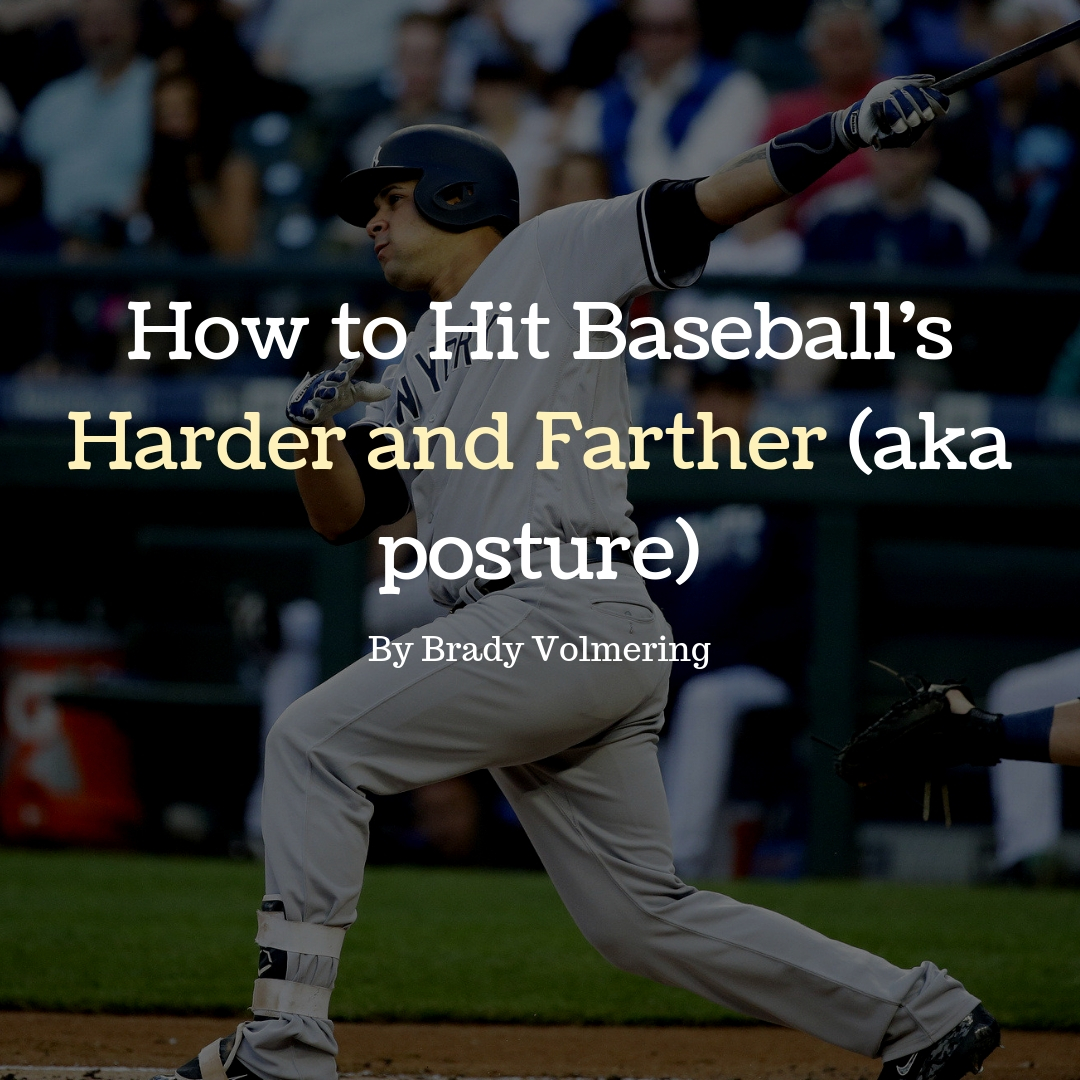Cheesy sounding article title? Sure. Wrong? No. With every hitting coach and their mother talking about how the hands do this in the swing, or the head needs to do that, or the radial rotation of your vertical forearm’s humerus needs to be 35 degrees (kind of made that up), I feel as if we are missing out on one of the most important pieces of the swing: posture.
What is posture? It’s definitely not this.
(Computer much bro?)
Let’s look at a couple pictures with lines, accompanied by video, to get a feel for what I’m talking about. Here are two different Mac Williamson extra base hits, one a HR and one a triple. Credit for the video goes to Craig Hyatt on twitter. Mini shoutout, if you are somehow reading this article and don’t follow him, go do so. Anyway, here are the videos:
#1:
#2:
This is what Williamson’s original posture looks like:
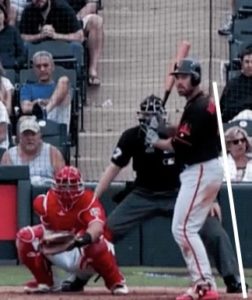
(Fancy line drawn by yours truly)
Here he is at contact on the HR:
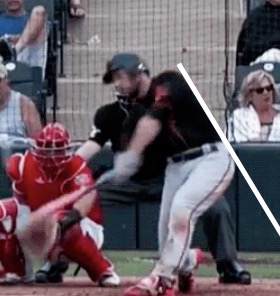
And here he is at contact on the triple:
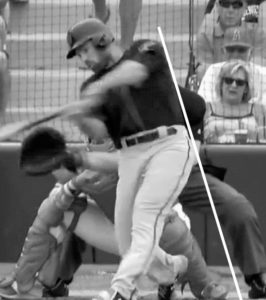
So, posture can essentially be thought of as the different line angles you see in the pictures above. Some pitches are going to require us to have more bend/hinge, and others will allow us to have less of those two things and stay more upright. I chose the two swings above not because Williamson is an All-Star (although I think he is going to have a much better year this year. See here), but because they illustrate two of the extreme postures we see with different pitch locations.
In the first picture and video, we see Williamson go yard on a ball that is below his kneecap, and then in the second we see him hit a ball hard for a triple on a ball that is a little bit above his belly button. One of the biggest issues I’ve found with hitters is they fail to create any sort of spine angle (posture) at all. In other words, they are upright nearly every pitch, causing several problems.
- Inability to hit balls flush
When you are upright with every swing you take, you don’t allow yourself the ability to work under baseballs that are in the lower part of the zone. Think about it like this. If you were to stand straight up and swing, the optimal pitch for you to hit is right at your shoulders. A pitch at that level will allow you to keep the bat in the plane of rotation of your shoulders while making contact with the baseball. Now, think about taking that same posture (completely upright), and trying to hit a pitch at your knees. Doesn’t work. To get a better feel for this, take a look at the image of Tiger Woods below.
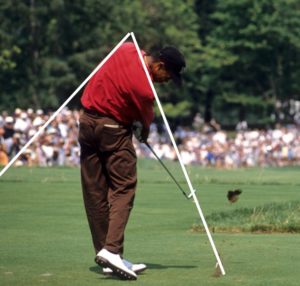
Golfing is a sport in which you literally have to hit the ball off the ground, which is the opposite extreme of the example I talked about above, where you would be hitting a ball at shoulder height. We can see in the screenshot above, when Tiger Woods makes contact with the golf ball, he has a ton of shoulder tilt/side bend. If we were to draw a line from his left shoulder straight through his right shoulder, all the way to the ground (as I attempted to do), we can see that it would run right through where the golf ball was originally sitting.
Appropriately matching your posture with pitch location, specifically vertical location (high or low), is going to allow you to work behind, up, and through more baseballs. Your bat wants to stay in the same plane of rotation as your shoulders. Matching your tilt with the pitch location will allow you to do that.
2. Loss of Power
Give me an example in which you are most powerful standing straight up. I’ll wait…
Yeah, there is none. Now, give me an example where your most powerful with some hinge/bend. Oh I don’t know…
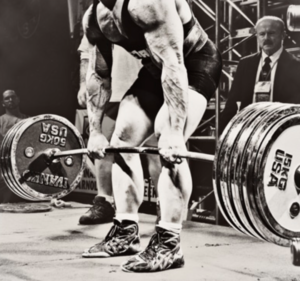
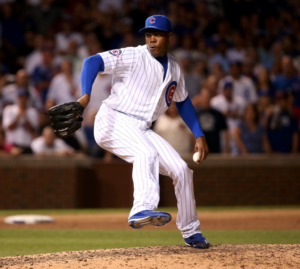
Getting some hinge/bend ultimately is going to allow us to activate muscles we wouldn’t otherwise use, at least to some extent. When you “sit down” into your glute, as we see with Chapman above, we are able to use more of the strength we have available from exercises like the deadlift, which you also see above. Without getting into a position that loads the larger musculature of the leg, we are losing out on potential power.
So how do we do it?
Great question. Ultimately, it just comes down to creating good angles with our body. The quote “it doesn’t matter where you start, it matters where you finish”, is appropriate here. Different guys start in all different kinds of stances. Straight up, open, closed, etc. This has very little bearing on the actual swing. The important part is when it comes time to rotate, in other words, when the front foot gets planted. Take a look.
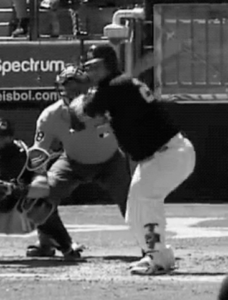
Gary Sanchez setting himself up to rotate.
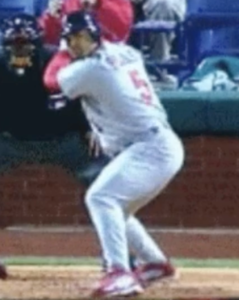
Albert Pujols setting himself up to rotate.
You can see in both of these they have some hinge in their hips, setting them up in a powerful position to rotate from. I want to take a closer look at Pujols, as the picture from above is from pitch that was at shoulder height:
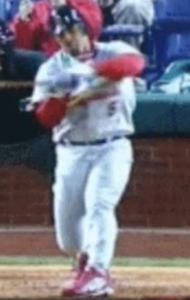
We can see here that he doesn’t hold his angle on this pitch, but that his torso ends up being almost completely upright. Here’s another swing in which the pitch is lower, allowing Pujols to hold his angle:
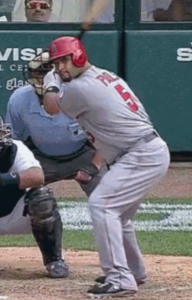
Pujols at footplant.
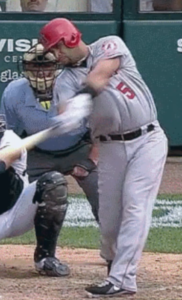
At contact, lower pitch.
Again, we see Pujols is in a similar position at foot plant, with some hinge in his hips, which he maintains through contact, due to the location of the pitch.
Conclusion
Different pitch heights are going to require different postures and different levels of tilt/hinge. What we saw above, is that we need to set ourselves up in a powerful position to rotate from, every time, and then adjust based upon where the pitch ends up.
Below is a simple and effective drill you can use to work on posture. I encourage you to take video from the front and see if your posture is matching the pitch (tee) location.
-Set up three tees, all at different heights. Put the first one just below your knee cap, the second at hip height, and the third at shoulder height. Take three consecutive swings and force yourself to make adjustments with your posture on each pitch.
That’s it for today, thanks for reading!
Looking for remote training? Email brady@dacbaseball.com for more info.
